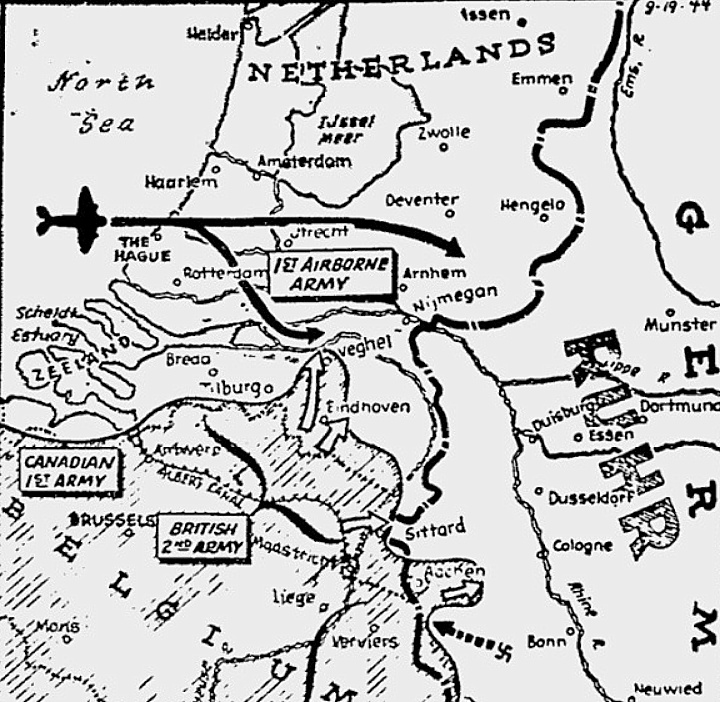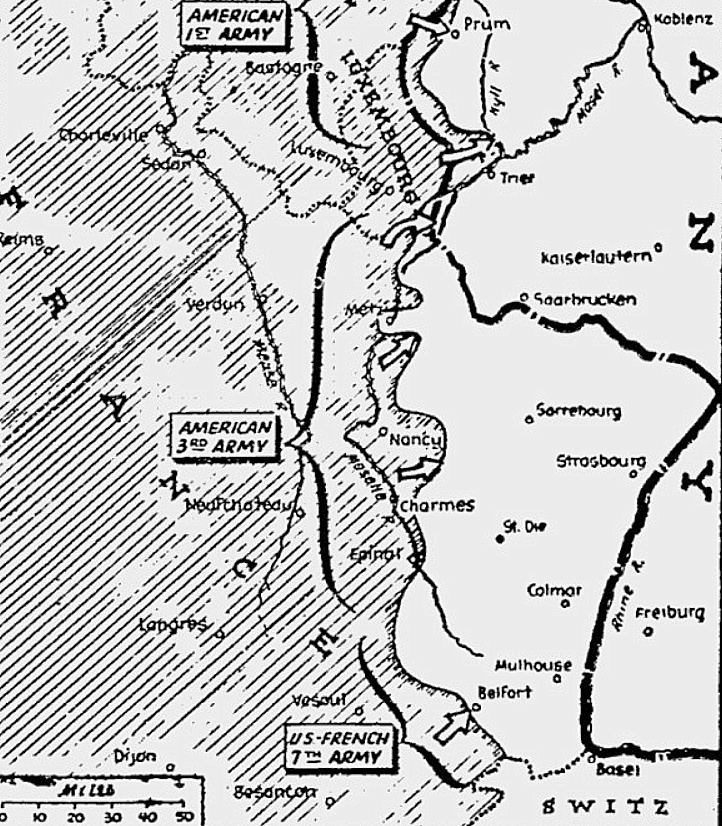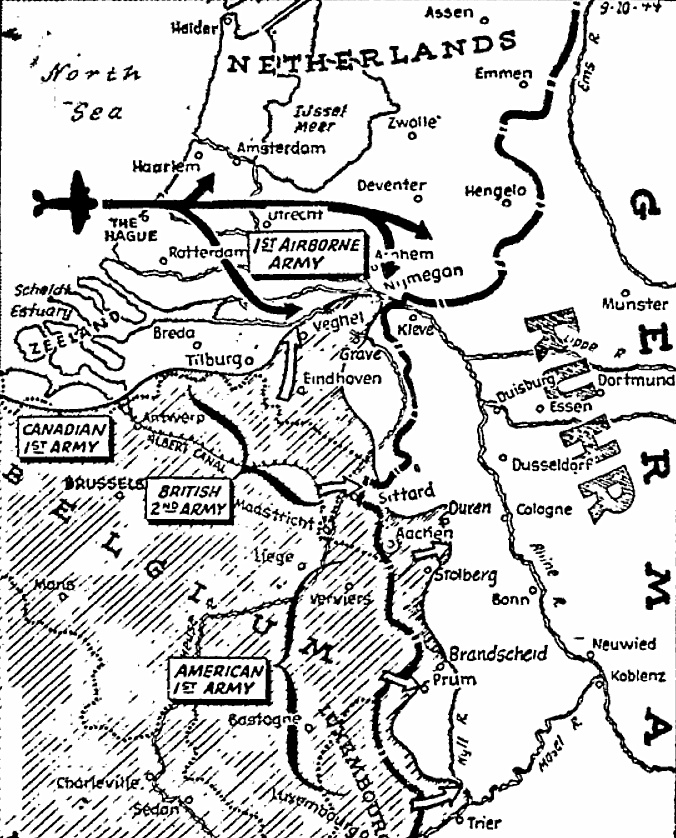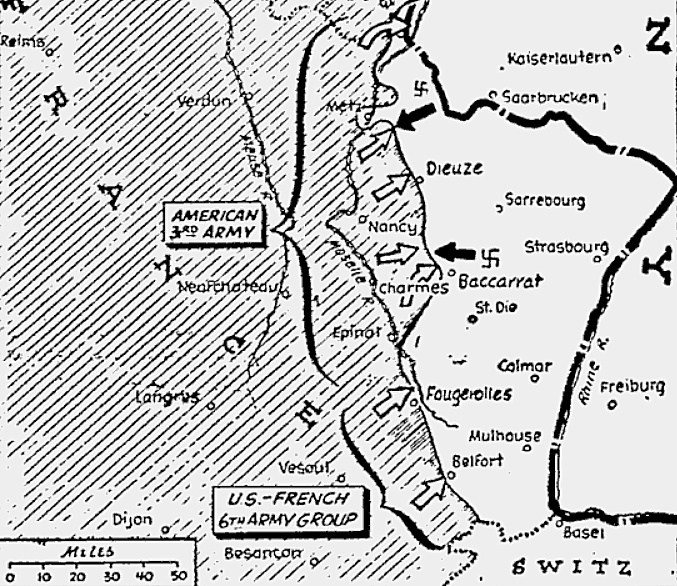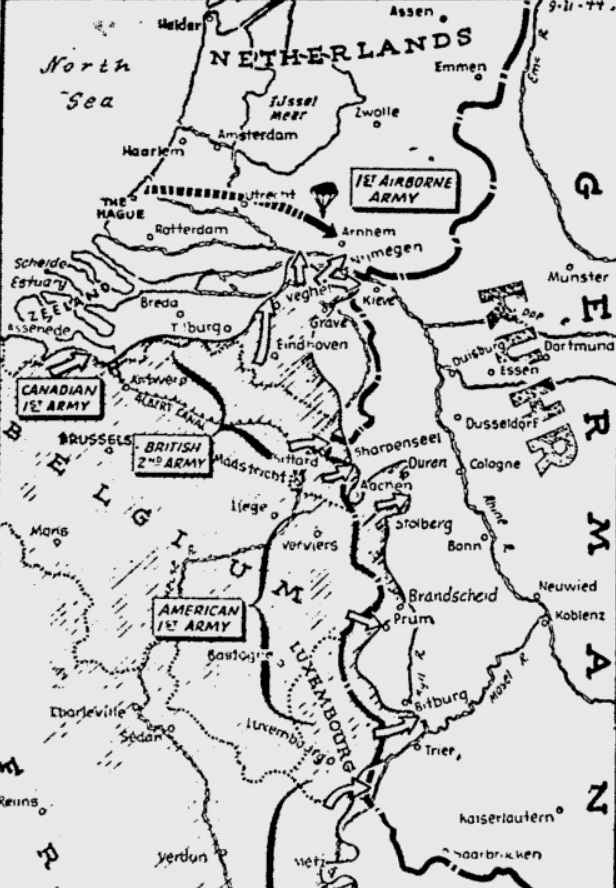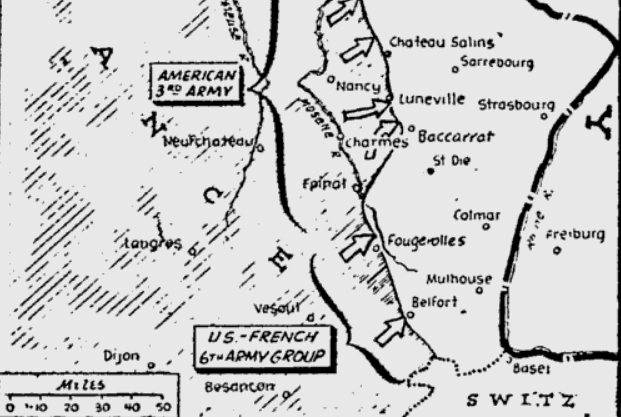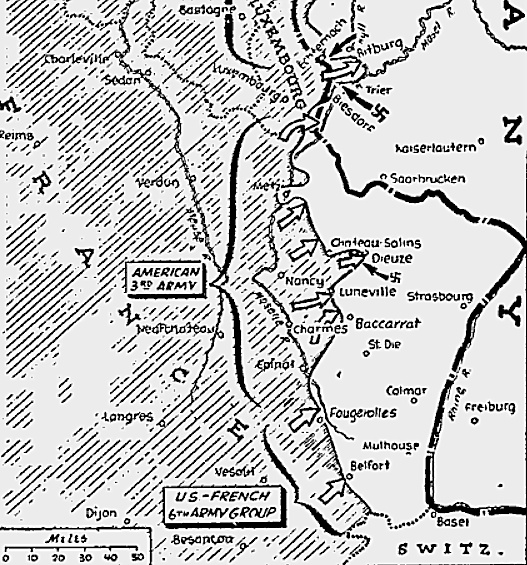The Pittsburgh Press (September 19, 1944)
Air army over Rhine; Dutch city captured
Brereton’s men turn Siegfried Line; Brest reported in U.S. hands
By Virgil Pinkley, United Press staff writer
Bulletin
With U.S. 1st Army on German-Luxembourg frontier –
U.S. armored units knocked out 26 German tanks in repulsing two counterattacks northwest of Trier today, boosting their bag in one sector to 50 in 36 hours.
Gaining in Holland, the 1st Allied Airborne Army was reported in position across the Rhine River at Arnhem to turn the German Siegfried Line and drive to Berlin. Meanwhile, the U.S. 1st Army crossed the German border at new points above and below Aachen. The British 2nd Army drove into Holland to join the 1st Airborne Army, the U.S. 3rd Army advanced from Nancy, and the 7th Army closed on the Belfort Gap. Far to the northwest, the 1st Canadian Army battled to clean up the Channel and North Sea coasts.
SHAEF, London, England –
Lt. Gen. Lewis H. Brereton’s airborne army turned the northern end of the Siegfried Line today in the Arnhem area of eastern Holland beyond the Rhine while other Allied forces captured the Dutch transport hub of Eindhoven.
Elated spokesmen said the aerial invasion of Holland was going exactly as planned on its third day and the commanders were highly pleased with its progress.
Front dispatches said the paratroopers and the British 2nd Army were wheeling through Holland at a lively clip, and the entire Nazi defense system for the country appeared to be falling apart.
Again today, an armada of Allied planes flew a supply mission to Holland, reinforcing the army which landed in the areas of Arnhem, Nijmegen and Eindhoven as well as other unspecified localities.
**The concerted onrush of the British 2nd Army and the airborne forces which brought them together in the Eindhoven area toppled the defenses of that big industrial city, and Lt. Gen. Miles C. Dempsey’s armor raced on in a fanout through a number of towns to the north and east.
Besides Eindhoven, the Allied seized Veghel (15 miles to the north), Esp (four miles to the north), Geldrop (four miles to the east), Wilreit and Luyksgestel (four miles north of Lommel) and Broek (one miles north of the Escaut Canal) where the British forced a new crossing in the Lille–Saint-Hubert area.
Far to the west, the battered German garrison of Brest, big French port famous for its role in World War I, had withdrawn to the Le Crozon Peninsula, Berlin said. The Nazi command said the city had been reduced to “smoking ruins” before it fell to the Americans who raced across Brittany early in August.
U.S. tanks and armor of Lt. Gen. Courtney H. Hodges’ 1st Army resumed their advance east of Aachen, breaking a stalemate brought about by brisk German counterattacks, and reached the outskirts of Stolberg, industrial city which had been bypassed in the drive which breached the Siegfried Line.
United Press writer Henry T. Gorrell reported from the region of Stolberg that the Germans had not counterattacked for 24 hours. Allied bombers were plastering the Nazi positions along a wide arc curving deep into Germany east of Aachen.
Can open path into Reich
With the Siegfried Line turned, if the airborne forces dropped in the Arnhem and Nijmegen areas can link up with the armored spearheads advancing north from Eindhoven, they will open a path for a fast dash into Northwest Germany.
The northern end of the Siegfried Line is at Kleve, 18 miles southeast of Arnhem. Arnhem is on the north bank of the Rhine branch which flows to the North Sea through Rotterdam. The landing forces were operating north of Arnhem and thus established north of almost all the main water barriers standing between the British 2nd Army and Northwest Germany.
The force in the Nijmegen area 12 miles south of Arnhem comprised an intermediary link between the Eindhoven and Arnhem forces. A quick junction will erect a great barrier behind an unofficially estimated 70,000 Germans in western Holland.
Make excellent headway
All available reports indicated that the Allied forces were making excellent headway and firmly holding the key positions they had seized.
United Press writer Ronald Clark reported from the 2nd Army front:
It appears that the German hope of fighting successfully for Holland or evacuating all troops from the Rotterdam and Amsterdam coastal areas is fading fast. Already the possibility appears of another gigantic bag closing around a big section of the Wehrmacht.
Strong British forces were moving swiftly northward across the first series of water crossings where the Germans hoped to defend the approaches to the Lower Rhine, Mr. Clark reported.
Claim some captured
The DNB News Agency said attempts by the airborne forces who landed in the Nijmegen area to gain a foothold in the town itself or the bridges which lead across the Waal River into it were frustrated.
The agency said single paratroop units landed in German territory next to the frontier, but claimed they were encircled and forced to surrender after a short fight.
A Brussels broadcast said the British 2nd Army was two miles from Nijmegen and crossed the Wilhelmina Canal at 5:30 a.m. CET.
Headquarters revealed that the airborne forces had already captured several hundred prisoners, most of them second-rate troops.
Mr. Clark revealed that the third wing of the 1st Allied Airborne Army had joined forces with armored spearheads of the British 2nd Army around Veghel.
The British 2nd Army was across the Belgian frontier into the Netherlands in great strength at three points above the Escaut Canal – north of Gheel, Lommel and Hechtel.
Front dispatches said the hard-hitting paratroops were spreading panic and confusion through the enemy rear, raising the possibility of a British march into the Ruhr similar to Lt. Gen. George S. Patton’s whirlwind drive across eastern France.
Battle for month
There was no immediate confirmation of the capture of Brest, where one of the bloodiest battles of the French campaign has been raging for more than a month.
About 20,000 Germans, including landlocked U-boat sailors and other naval personnel, dug into the city when the Americans broke into the Breton Peninsula and held out stubbornly under heavy attack from land, sea and air to prevent the Allies from obtaining the use of the first-rate port facilities.
Gen. Patton’s U.S. 3rd Army broke the stalemate on the Moselle River with a powerful eastward thrust toward the German frontier that carried at least 20 miles beyond Nancy and tightened the ring around Metz.
Close in Belfort
Simultaneously, the U.S. 7th Army squeezed in closer to the Belfort Gap against stiffening opposition, and 1st Canadian Army troops on the French Channel coast fought into the streets of Boulogne at bayonet point.
The U.S. 1st Army drove across the Dutch border into Germany east of Simpelveld, seven miles north of Aachen, a second spearhead striking beyond captured Maastricht neared the border in the area of Sittard, 17 miles northwest of Aachen.
Aachen itself was closely enveloped and official reports indicated some doughboys had fought into the streets of the city.
Beat off attacks
Southeast of Aachen, Gen. Hodges’ men beat off desperate counterblows by German tanks and shock troops, losing some ground under the enemy assault and then coming back to capture several towns well inside the border, including Höfen and Büsbach.
Farther south, the Americans also expanded their salient inside Germany above Prüm and made a new penetration of the Reich at Hüttingen, 20 miles below that town.
United Press writer Robert Richards reported from the 3rd Army front that Gen. Patton’s men were on the move toward Germany again after a long stalemate imposed by supply difficulties.
30 miles from border
One armored spearhead pushed beyond Nancy to within about 30 miles of the German border, apparently aiming at Strasbourg, while other units crossed the Moselle River in force below Metz, threatening to outflank that fortress.
Below Nancy, another U.S. infantry column, spearheaded by French armor, advanced 15 miles northeast of Charmes.
At one point, fanatical Nazi SS troops launched a wild bayonet charge against the American vanguards, only to be slaughtered by Yank machine-gunners and riflemen, Mr. Richards said.
